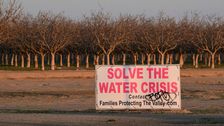[ad_1]

California Gov. Gavin Newsom (D) rolled out a slate of actions in response to growing drought conditions across the state, where wildfires and other dry-weather dangers have plagued the state throughout the past decade.
Speaking Wednesday from a dry portion of Lake Mendocino that would normally be under water, Newsom declared a state of emergency for for the Russian River watershed in Mendocino and Sonoma counties, which have both been ravaged by wildfires in recent years.
“Oftentimes we overstate the word historic, but this is indeed an historic moment, certainly historic for this particular lake, Mendocino, which is at 43% of its capacity this time of year,” Newsom said.
The state of emergency does not include any mandates but does allow the state water board to modify requirements for reservoir releases on the Russian River watershed and curtail water diversions from the watershed, which farmers may use to irrigate their crops.
Drought is not isolated to those counties, Newsom acknowledged, and said more counties could be added to the declaration as dry conditions persist. Other actions Newsom signed Wednesday aim to prepare the state to quickly respond as drought conditions worsen, including directives for local water agencies to make Californians aware of low water tables, assisting farmers and native tribes with preparing for drought conditions and accelerating funding for drought response projects across the state.
“The hots are getting hotter, the dries are getting drier,” he continued, nodding to the role climate change plays in drought conditions. The California Department of Water Resources just designated 2021 as the third-driest water year, a period that runs from October to March, on record.
But farmers in the state’s Central Valley counties say they need drought assistance now. On Monday, lawmakers from throughout the region sent a letter to Newsom pleading with him to make a statewide drought emergency declaration.
Newsom’s actions come as much of the state embraces for another potentially catastrophic wildfire season this summer into the fall. Many are already starting to feel the effects of it.
“We now have, year to date, experienced two times as many wildfires and twice as much acreage burned than we have averaged over the course of the last five years,” he warned.
Californians are familiar with adjusting their lifestyles in response to prolonged dryness. During the drought that lasted from 2011 to 2017, for example, people were required to cut back on water usage by 25% and dozens of rivers were closed to fishing.
Calling all HuffPost superfans!
Sign up for membership to become a founding member and help shape HuffPost’s next chapter
[ad_2]
Source link